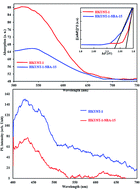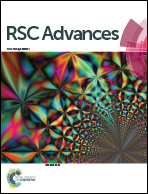Photocatalytic degradation of binary mixture of toxic dyes by HKUST-1 MOF and HKUST-1-SBA-15 in a rotating packed bed reactor under blue LED illumination: central composite design optimization†
Abstract
A new composite of mesoporous materials, HKUST-1 metal organic framework and SBA-15, was synthesized and applied to the simultaneous visible light photodegradation of a binary mixture of safranin O and malachite green. Structural and electronic properties of the samples were characterized by X-ray diffraction (XRD), scanning electron microscopy (SEM), Fourier transform infrared (FTIR), Brunauer–Emmett–Teller (BET), Barrett–Joyner–Halenda (BJH), photoluminescence (PL) and diffuse reflectance spectroscopy (DRS). In the photodegradation process, a rotating packed bed reactor was used to enhance mass transfer and the distribution of irradiance. In the rotating packed bed reactor, by creating a rigorous centrifugal field due to high rotational speed, thick liquid films are converted into thin layers and small droplets, therefore the interfacial area between pollutants and photocatalyst particles increases and mass transfer is improved dramatically. The benefits of visible-light-emitting diodes (LED) compared to UV lamps are economically significant. In the reactor applied here, a blue LED strip with high mechanical flexibility was wrapped around the reactor vessel for uniform irradiance distribution. The influence of the initial dye concentration, rotational speed, solution flow rate, photocatalyst dosage and irradiation time on the photodegradation efficiency and the relationship among these parameters were investigated to find the optimum operational conditions using response surface methodology based on a central composite design (CCD). The results showed that applying HKUST-1-SBA-15 is cost-effective, due to less rotational speed and irradiation times. Investigation on the kinetics of the photodegradation reaction showed that the experimental data follow a pseudo first order reaction, based on the Langmuir–Hinshelwood model.

- This article is part of the themed collection: Zeolites and 3D Porous Solids

 Please wait while we load your content...
Please wait while we load your content...